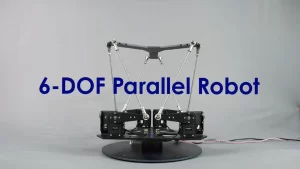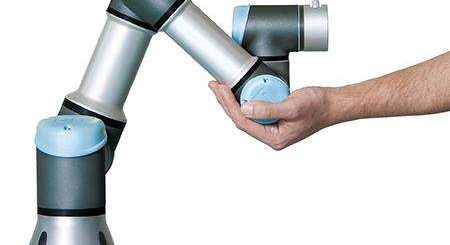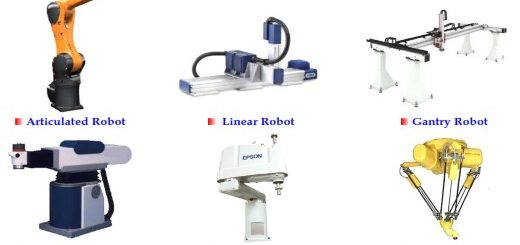Parallel Robot importance, risks, Serial robot vs parallel robot
Parallel robots can be used as high-precision milling machines, drilling machines, or other cutting tools. Their rigid structure ensures stability and accuracy during delicate machining processes. Their simpler design for some aspects of control and their robust structure make them valuable tools in various industries.
What is Parallel Robots?
Parallel robots, also known as parallel manipulators, are a distinct type of robotic design characterized by their unique structure and movement. The name “parallel” comes from the concept of having multiple parallel kinematic chains working together, not from the actual geometric parallelism of the limbs themselves.
Unlike regular robots with serially connected links, parallel robots have a fixed base connected to a moving platform by multiple independent limbs (usually 3 or 6). These limbs, often employing a combination of prismatic and rotary joints, move in a coordinated way to position and orient the moving platform precisely.
Parallel robots are powerful tools in specific situations. If your application demands high speed, precision, and handling significant weight within a defined workspace, a parallel robot might be the perfect solution. Parallel robots excel in high-speed, high-precision applications with a well-defined workspace. For tasks requiring large reach or complex maneuvers, serial robots might be a better choice.
Features of Parallel Robots
The rigid design with a fixed base and shorter moving parts allows for very fast and precise movements. The distributed actuation (multiple limbs) creates a very stiff structure, enabling them to carry heavier payloads compared to similar-sized serial robots. Calculating the required motor movements for a desired platform position (inverse kinematics) can be easier than in serial robots.
Applications of Parallel robots
Parallel robots are ideal for applications requiring high speed and precision within a defined workspace. Examples include:
- Tasks of pick-and-place in high-speed automation (e.g., food packaging).
- Flight simulator platforms that move with high agility.
- Machine tool applications that require precise movements and strong load capacity.
- Medical rehabilitation robots that can assist patients with movement therapy.
Actuation and Control
Like most industrial robots, parallel robots are typically driven by electric servo motors for precise control. However, some can also use pneumatic or hydraulic power sources. The control systems for parallel robots need to handle the combined movements of these multiple limbs to achieve the desired motion of the platform.
What can Parallel Robots do?
Parallel robots shine in tasks that demand a combination of three key strengths: speed, precision, and handling hefty payloads. Their rigid design and multiple limbs working together allow for incredibly fast and accurate movements. This makes them perfect for high-volume, fast-paced applications like:
- Parallel robots can handle tasks such as sorting and packing delicate food items or assembling electronic components at lightning speed.
- The distribution of actuation (multiple limbs moving the platform) creates a very stable structure. This translates to high stiffness, enabling them to handle heavier objects compared to similar-sized serial robots.
Applications requiring this strength include:
- The need for both high speed and the ability to handle the weight of the simulator platform makes parallel robots well-suited for creating realistic motion experiences.
- Calculating the required motor movements to achieve a desired end effector position (inverse kinematics) is often easier in parallel robots compared to serial robots. This can be beneficial for certain control applications.
Importance of Parallel robots
Their rigid design with a fixed base and shorter moving limbs allows exceptional speed and precise movements. This makes them perfect for high-speed pick-and-place applications like food packaging.
The distributed actuation (multiple limbs moving the end effector) leads to a very stable structure. This translates to high stiffness, enabling them to handle heavier payloads compared to similarly sized serial robots.
Calculating the required actuator movements for a desired end effector position (inverse kinematics) is often easier in parallel robots compared to their serial counterparts.
Parallel robots are a valuable tool for specific industrial needs. Their strengths in speed, precision, and handling weight make them well-suited for tasks in various industries.
Risks of Parallel robots
While the inverse kinematics might be simpler, the forward kinematics (calculating the end effector position based on actuator movements) can be more complex. This can lead to challenges in robot control. The parallel robots‘ structure restricts their range of motion compared to more flexible serial robots. They might not be ideal for tasks requiring a large working area.
Certain configurations can cause singularities, where small motor movements result in unpredictable movements of the end effector. These singularities need to be avoided during operation, adding a layer of complexity. These need to be carefully avoided during operation.
While these robots offer impressive capabilities, it’s important to remember their limitations. Their workspace, the area they can reach, is generally smaller compared to serial robots. Additionally, their design complexity can make them less suitable for tasks requiring a large range of motion.
Parallel robots may not be able to navigate around obstacles as easily. Determining the end-effector position based on actuator movements (forward kinematics) can be more challenging for parallel robots, sometimes having multiple solutions.
You can subscribe to Science Online on YouTube from this link: Science Online
You can download Science Online application on Google Play from this link: Science Online Apps on Google Play
Serial Robots review, advantages, disadvantages and what can serial robots do?
Collaborative robot arm (cobot robots) applications, uses, advantages and disadvantages
Automation in manufacturing uses, advantages and disadvantages
Industrial robot (Auto industry) uses, advantages and disadvantages




